There are SaaS companies that heavily rely on webinars and virtual events, virtual conferences, and keynotes. For example, we at Reply host the Sales Development Excellence — an annual virtual event for SDRs and sales leaders. Vidyard has Fast Forward, Miro runs Distributed.
While COVID-19 has affected the way we consume content and network, in-person events are slowly returning to our lives. When it comes to SaaS media companies, there are some examples here as well: RoadShow by Profitwell, Outreach Unleash, Mind the Product Conferences.
Community may be the most important part of a SaaS media company strategy, as a friendly community of professionals who share the same values and have the same problems will help keep the media company alive. This one is also often called “community-led growth.”
Some of the common types of a SaaS community are a job board, a Q&A forum, a Slack/Facebook group, a mentorship or educational program, or 1-on-1 intros and community members matching.
The Community Club, Makerpad, RevGenius, and Mind the Product I’ve mentioned earlier have implemented almost all these things.
Social proof and thought leadership
But there’s one more tactic to boost SaaS growth related to content marketing. This one relies on social proof and thought leadership to grow awareness and customer acquisition. Here are some of the ways you can implement it in your SaaS business.
Let’s start with my personal favorite here — the so-called “wall of love.” This is a nice twist on the traditional testimonials page, a centralized hub where you aggregate customer testimonials from different platforms (G2, Product Hunt, Capterra, etc.) or social mentions in one place and organize them into beautiful boards. As Testimonial puts it, a wall of love is “the best social proof we can get!”
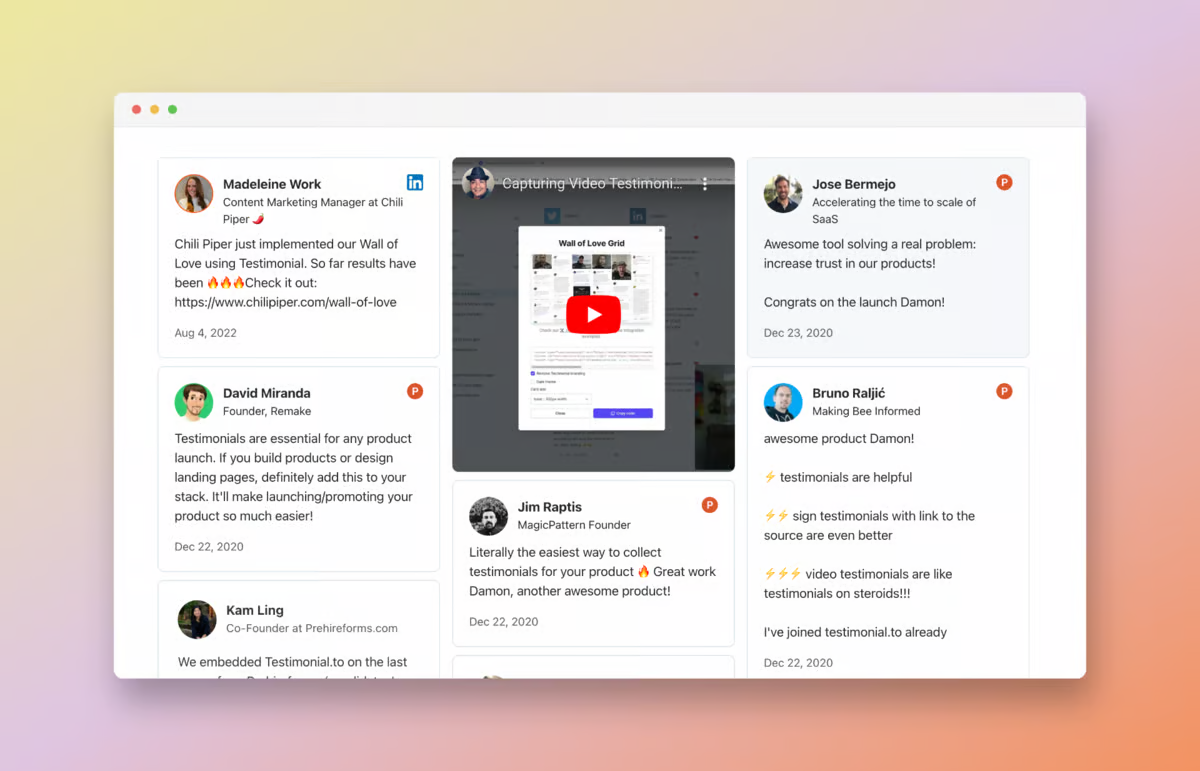
Partnering with thought leaders and influencers to promote your product isn’t new. B2C companies do that all the time. As to B2B SaaS growth strategy, one interesting trend I’ve noticed is that more companies build long-term relationships with industry influencers having them join the team as strategic advisors. Being officially affiliated with a company, they can advocate for the product on social media, events, etc.
You can even get more creative here and team up with a celebrity for a fun cameo like acquire.com did with Russ Hanneman.
On the other hand, your ambassadors don’t necessarily have to be famous influencers. You can get your loyal customers to advocate for you as well. As nano-influencers with just 1-2-3k followers, they can look more genuine and trustworthy (unlike most thought leaders who are obviously getting paid to promote your brand). We’ve tried partnering with both top influencers and smaller niche thought leaders, and the latter drive much better outcomes.
One more tactic I don’t just preach but also actually practice myself is social selling on LinkedIn. Namely, we’re actively building personal brands for our key stakeholders (CEO, CMO, VP of Product) to increase our reach and raise awareness.
However, I’ve also discovered that genuine, personal engagement on social media is just as important (but much easier) than creating your own content. What I call comment marketing is a great addition to any SaaS social strategy. And it can be scaled outside of traditional social media channels like LinkedIn to reach relevant audiences on Quora, Reddit, Twitter, Threads, or relevant Slack communities.
Product-led growth tactics
While product-led growth tactics should be the subject of a whole different blog post (for example, here’s one explaining the role of PLG in sales), I couldn’t leave out a few creative hacks that could be a great addition to any SaaS growth strategy.
It’s amazing to see how quickly this SaaS product category has emerged, and how it’s transforming the way we showcase products and services online. This is a great opportunity to free up your sales team’s time, especially considering the average demo no-show rate of 13.3% and the fact that 30% of demos are unqualified.
As a result, such interactive self-serve experiences delivered by tools like Navattic, Walnut, or Storylane are becoming a key element of PLG strategies, helping businesses drive engagement, reduce friction in the buying process, and ultimately accelerate growth.
Another product-related growth tactic here focuses on customer onboarding. From in-product tips or interactive checklists to full-fledged educational courses, there are many ways SaaS products can facilitate growth through intuitive and smooth customer onboarding.
As a part of customer onboarding, some products would also offer support with data migration, especially to users who are switching from a different provider. This could be a great opportunity to offer more value to the users as well as lower the barrier to entry.

On top of that, you can also encourage your new users to invite their teammates or colleagues from other departments who would also benefit from the product to sign up as well.
Announcing product updates is a great way to keep your customers engaged as well as attract new users. Two key elements here are:
- What you announce — adding a cool new AI feature might seem like a great idea, but if your users have been asking for an autosave or single-click sign-up for months, you’d better focus on that instead.
- How you do that — in-app announcements might be a great way to keep your users informed, but breaking the news to the broader audience on social media or Product Hunt is what you need to drive real growth.
There are also many examples of SaaS brands teasing new features or important announcements in advance to build up anticipation and pique the audience’s interest.
All in all, “building in public” could be a great addition to any SaaS growth strategy.
If you think that localizing your product only makes sense if you officially expand to a certain country or region, you’re wrong. This is the main benefit of running an online business — you can tap into the local markets to grow your user base anytime simply by translating your product UI (aka localization) into the target language.
Localized pricing is another smart hack used by a lot of SaaS companies. The least you can do here is to show your pricing plans in the relevant currency (rather than US dollars). If you’re up for a more sophisticated tactic, try implementing dynamic pricing to charge users in specific locations based on the market saturation as well as their purchasing power.
A good example here is Netflix’s localized pricing (here’s how much it would cost for people in different countries to watch their favorite shows).
Pricing growth tactics
Speaking of SaaS pricing, there are more creative tactics to drive product growth here. Let’s break down some of them.
- Forever free or freemium plans with usage paywalls
Salespeople might not like free or freemium pricing for their products — and for a good reason! But when it comes to growth, lowering the barrier to entry can work wonders. Yes, they might be limited in features or scale, but at least free products are easy to “get hooked” on.
BTW, did you know that Reply now has a completely free plan? With 200 monthly data search credits and AI sequence generation, this is a great starting point for your sales engagement journey.
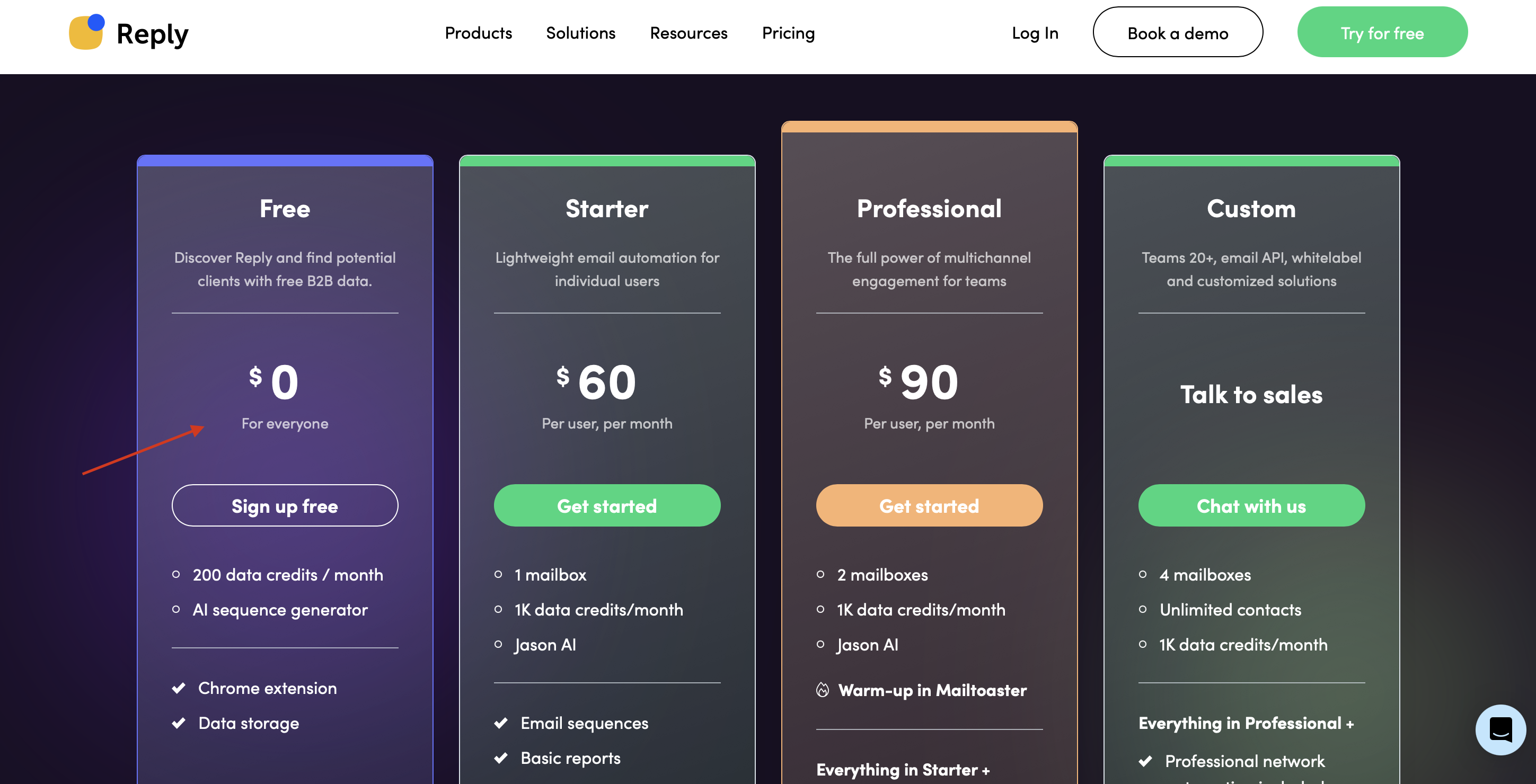
The only drawback of freemium pricing for SaaS products is that you will still have to convince those users to switch to the paid plan, so don’t give away too much for free 😉
This is where usage paywalls come in handy. They are usually implemented as a part of the freemium pricing plan to limit the product capabilities or capacity available to nonpaying users.
So if you hit the limit of your free plan or want to access a premium feature, you will see a pop-up notification offering an upgrade. This tactic is also commonly used for integrations as many sales tools, including Salesforce and Lusha, offer this only as a part of their paid pricing plans.
Or you can choose a completely different approach allowing for unlimited scalability with usage-based pricing. Often referred to as pay-as-you-go pricing, this is a flexible pricing model where you charge the users based on their actual usage of your product.
You can also offer usage-based pricing options along with traditional fixed fee plans as a more flexible option for enterprise or agency users. Some products might even implement this tactic through paid add-ons to their key offering. For example, you can purchase additional data search packages to ramp up your prospecting efforts with Reply Data.
This is a popular tactic among prospecting tools (data providers or email finders), no-code automation platforms, or API products, etc. A few notable examples here are Zapier, Clearbit, Twilio, Intercom, Copy.ai, etc.
- Discounts and special offers
Another way to grow your product is by offering discounted pricing or special offers. This can be dedicated to certain holidays, e.g., traditional Black Friday deals that are the lifeblood of the Q4 quota attainment.
Many SaaS products would also offer special promo offers as a part of their Product Hunt launch or even list their lifetime deals on AppSumo. Both are valid tactics to quickly grow your user base.
Pro tip: Keep in mind that you will have to serve those one-time buyers in the long run for free, so think twice if it’s really worth it.
You can also create discounts or offers tailored to certain audience segments or use cases. A great example here is the startup programs that offer discounted pricing or some extra perks to early-stage startups. This is a smart tactic for building mutually beneficial relationships with companies that have a high growth potential and will bring more value down the road.
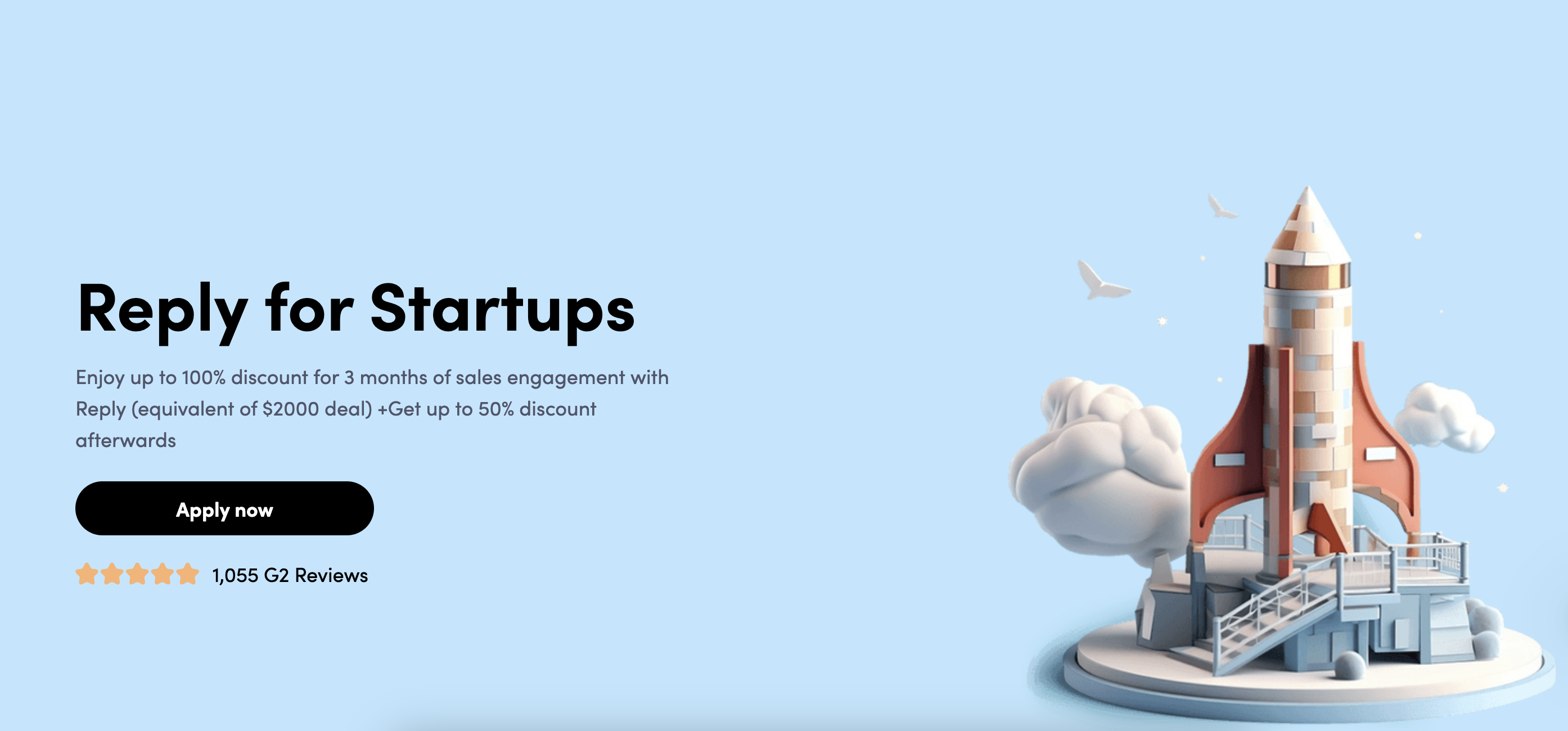
Apply to join Reply Startup Program
Growth through added value
However, the value a business can offer to prospects goes beyond discounts or special offers. Let’s explore some of the ways to drive B2B SaaS growth through complementary products or services.
- Freebies and sidecar products
Everyone loves a freebie! But if you’re not ready to give away your main product, you can come up with a complementary tool to boost awareness and growth. This can be anything from appealing lead magnets, like our signature generator or sales commission calculator to various browser extensions, plug-ins, add-ons, or desktop apps that make your product easier and more convenient to access and use.
A slightly different approach to this tactic is to offer a standalone tool that isn’t directly related to your main product. A good example here is our own Name2Email extension — a free email finder that has been growing organically as a standalone product with little to no marketing or other investments.
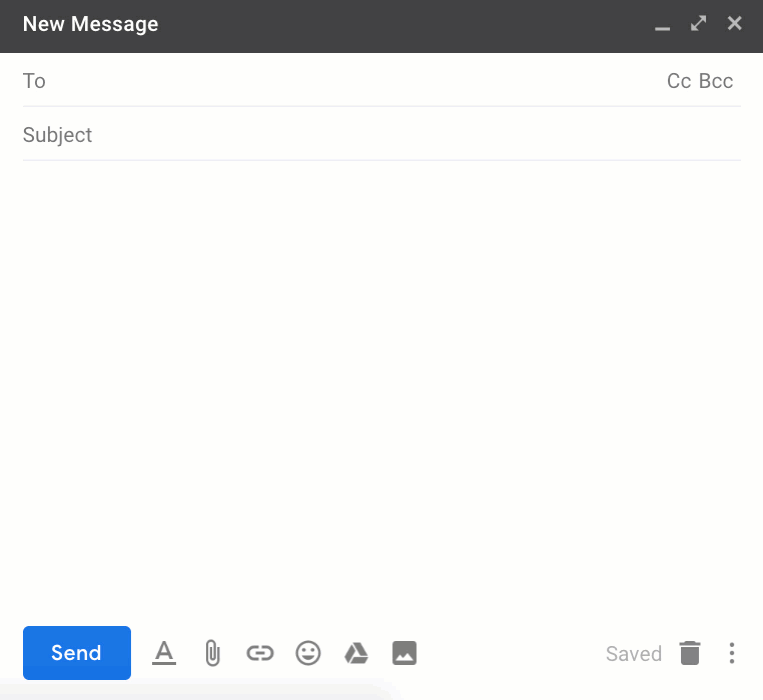
More examples of sidecar products include Zappy by Zapier, LinkPop by Shopify, MicroMRR by MicroAcquire, etc.
Priority support via Slack or a dedicated customer success manager that will handle technical setup as well as proper onboarding and training for bigger clients has already become a kind of industry standard for SaaS products targeting middle or enterprise businesses. However, there’s more value you can offer to your users with complementary professional services.
For example, I notice more sales engagement products offering complementary prospecting services or deliverability consulting. This is typically implemented for high-tier pricing plans (custom or enterprise) or sold separately as an add-on or via partnerships.
Recent news in the SaaS industry, including Adobe’s acquisition of Figma, Zoom’s launch of Zoom Mail and Zoom Calendar, and Canva’s introduction of Visual Worksuite, signify one more exciting SaaS trend — compound products. Put simply, this means consolidating multiple software solutions within a single, integrated platform to create more seamless and streamlined experiences for customers.
What does it have to do with growth, you ask? As a compound product, you can expect a higher user and feature adoption with lower total integration and support costs, which can help strengthen your position in the market.
One more interesting micro-trend here is that many compound SaaS products start positioning themselves as an “operating system (OS).” Take, for example, Intercom’s Engagement OS, Selldone’s Business OS, or a whole list of various OS products from ZoomInfo.

Outbound as a growth tactic
Outbound is typically considered an old-school sales/marketing tactic unfit for the dynamic world of B2B SaaS growth. And that’s true, at least to some extent. The default outbound outreach where you send slightly personalized messages to the high-volume contact list isn’t an option here. The only growth this can get you is in the number of bounces and spam reports.
So instead of relying on SDRs and traditional tech stacks, companies start hiring outbound growth reps who rely on no-code prospecting tools and can build creative, intent-based outreach strategies.
As a result, unlike traditional SDRs, outbound growth reps require a completely different skillset:
- Analytical and builder mindset to handle complex workflows, e.g., build an automated process to scrape this job board, call a few enrichment APIs, and push data to Airtable.
- Technical skills to use various APIs and no-code tools, build integrations, etc.
- Creativity to stand out from the crowd and increase reply rates.
- Business background to get an in-depth understanding of the current buyer personas and discover new audiences to target.
To cater to this new generation of outbound reps, multiple trends emerge in SaaS, from no-code prospecting tools like Clay, Rows, Airtable, and Captain Data, to various hyper-personalization techniques (mostly involving AI).
This is the trend we closely follow at Reply — by implementing outbound as a tactic for our own growth as well as rebuilding our sales engagement platform to implement more powerful AI features for smart automation and personalization. Learn more about the latest product enhancements here.


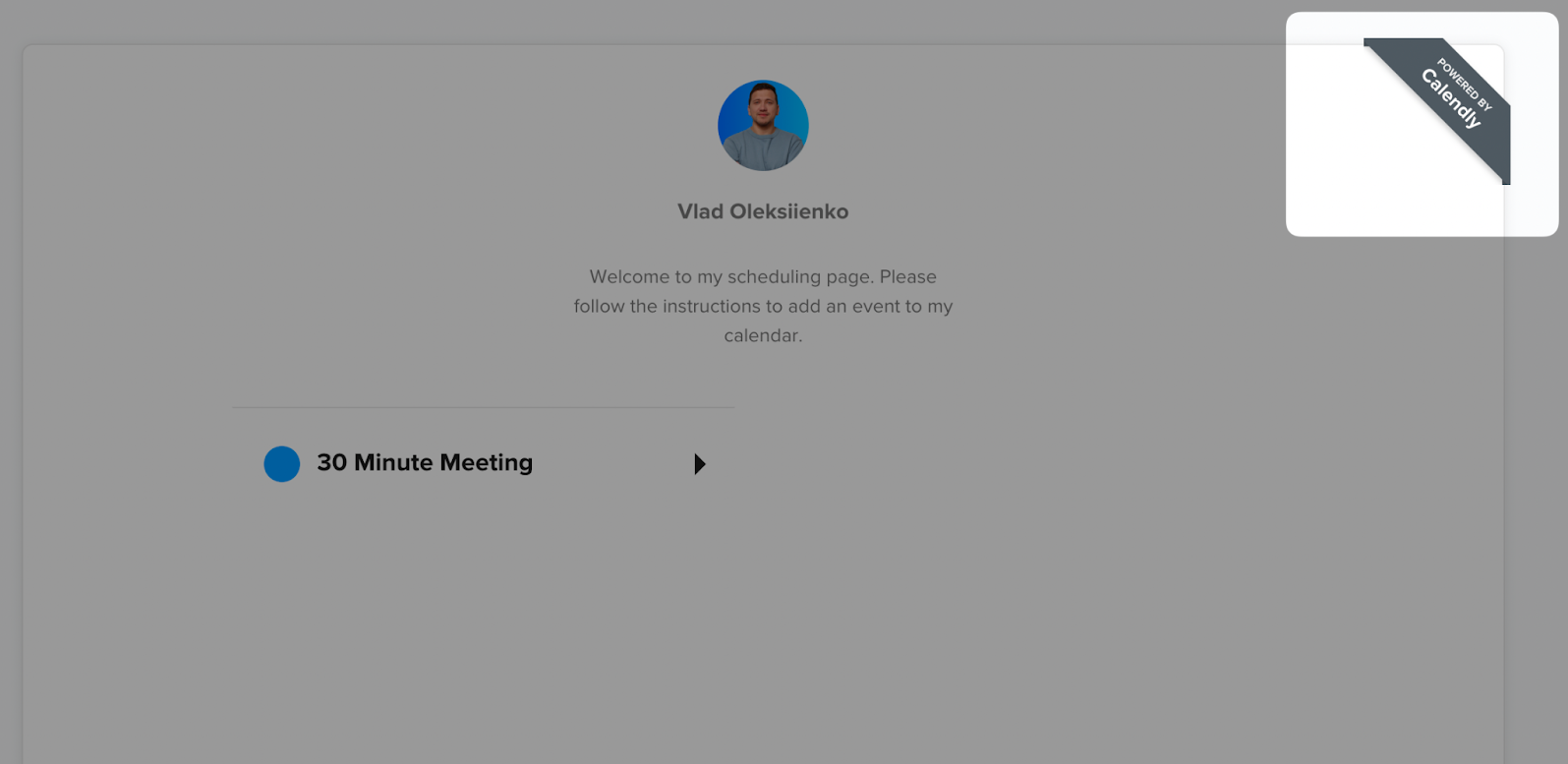






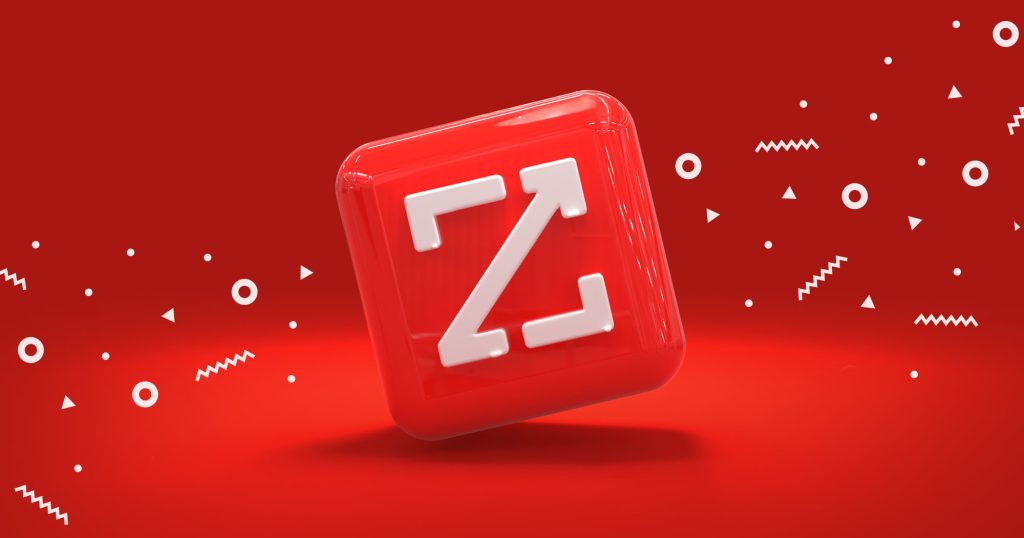


![How to Write Your Perfect LinkedIn Connection Message [With 15+ Templates] How to Write Your Perfect LinkedIn Connection Message [With 15+ Templates]](https://reply.io/wp-content/uploads/linkedin.messages-1024x538.jpg)